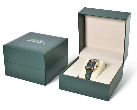



Quality
guarantee
Environmental
protection
Novel
design
Professional watch / gift / candy boxes manufacturer


The earliest way for humans to judge time is to calculate the passage of time between darkness and dawn. Then about six thousand years ago, the "concept" of calculating time appeared on the stage of human history for the first time: the sundial was born in the Kingdom of Babylon (sundials appeared later in China). The ancients used sundials to keep track of time based on the length and direction of the sun's shadow. Four thousand years ago, the engraved clock was invented, allowing people to know the time day and night. The appearance of clocks only occurred after the middle of the thirteenth century.
The early mechanical clocks that appeared in northern Italy and southern Germany around 1270 were powered by scales and sounded the attached bell every hour to automatically tell the time. In 1336, the first public clock was installed in a church in Milan. In the next half century, clocks spread to various European countries, and bell towers were built in churches in France, Germany, and Italy.
Soon, clockwork technology was invented and the size of clocks was greatly reduced. In 1510, a German locksmith produced the first pocket watch. At that time, the production of clocks seemed to be limited to the side job of locksmiths. It was not until later that the requirements for clock accuracy became higher and higher, and the watchmaking skills became increasingly complex, and professional watchmakers appeared.
Breguet's archives record an order. This order came from Carolina Murat, Queen of Naples (Napoleon's sister). The order was recorded on June 8, 1810, and the content of the order was an "oval bracelet timepiece"! In the early 19th century, it was already Wristwatches appeared? This is a bit unbelievable. It is generally believed that wristwatches designed for women made their debut around 1880, and men’s wristwatches were born shortly thereafter, around 1910. However, the discovery in Breguet’s archives advanced the history of wristwatches by more than half a century! This is a watch that pays attention to decoration and is made into a bracelet shape.
At that time, pocket watches were popular in the men's world as a symbol of identity and status, and watches were regarded as women's accessories. In order to commemorate such an important time, Breguet created the Naples jewelry watch.
early this century. WILSDORF&DAVIS, the predecessor of ROLEX, launched silver gentlemen's watches and ladies' watches, which was a great success, leading various watch manufacturers to compete in the development of watches. Switzerland, which was world-famous for its pocket watch skills, also took the lead in watch production. In 1926, ROLEX developed the completely waterproof watch "ROLEX OYSTER". In 1931, it was the first to introduce the self-winding watch "OYSTER PERPETUAL" to the market. LONGINES (Longines) Company was not to be outdone. The precision aviation clock it developed flew across the Atlantic with the American aviator Lindbergh and became famous. In 1929, the watch "CHRONOGRAPH" with stopwatch function was launched. The following year, the precision watch "CHRONOMETER" was developed on this basis.
After World War I, watches began to become popular among the people, and people began to regard watches as a spiritual accessory. During World War II, the German army began to equip a large number of watches, and the popularity of watches reached unprecedented levels.
In the late 1960s, a new page opened in the history of mechanical watches: In 1969, Japan's Seiko Watch Company developed the world's first quartz electronic watch, with the daily error reduced to less than 0.2 seconds. The quartz revolution officially broke out, and a large number of traditional watchmaking brands in Switzerland went bankrupt, including today's Blancpain (after resurrecting, Blancpain vowed never to make quartz watches).
New technologies in the watch manufacturing industry are emerging one after another, but mechanical watches are not dead. Although the output has been greatly reduced, the manufacturing skills have been preserved. In particular, Swiss watch manufacturers, even though quartz watches dominate today, still have a special liking for mechanical watches. They insist on producing high-end mechanical watches and continuously export them to all over the world.
Today, Swiss watches and Japanese watches occupy the high-end and low-end watch markets respectively. In the future, we will wait and see whether smart watches can set off another revolution!

Phone:+86 136 5269 1365
Email:[email protected]
Address:No.18 Fuxing Road, Xiagang Community, Chang'an Town, Donguan City, Guangdong Province





